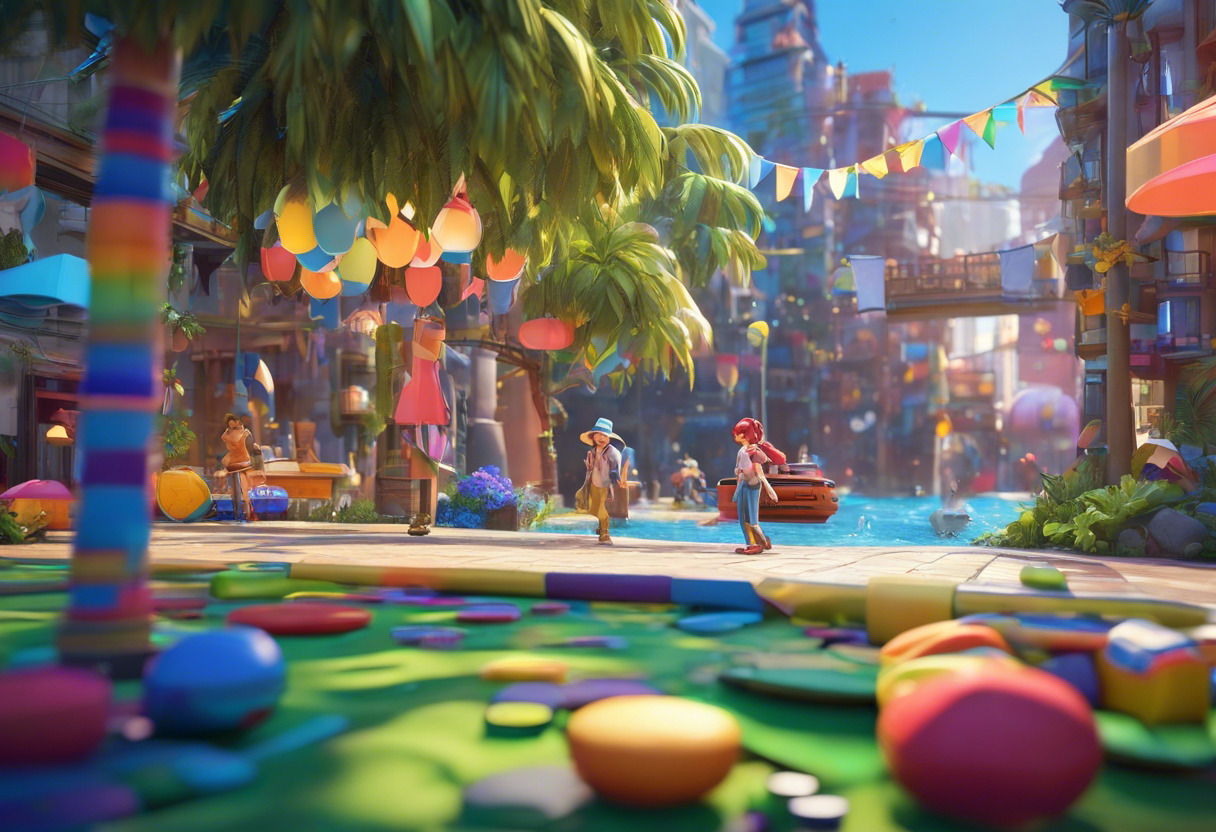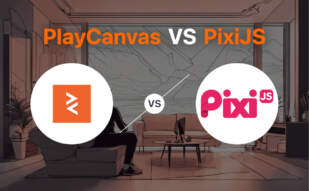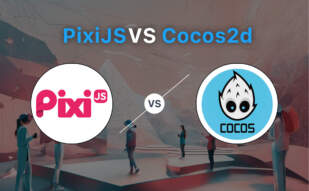In the PlayCanvas vs Cocos2d stakes, PlayCanvas outshines for collaborative, cloud-based 3D development, GPU accelerated graphics, and support for WebGL standards. It’s ideal for advanced developers requiring simultaneous editing. Yet, Cocos2d excels in 2D game creation with a software-friendly framework. It’s excellent for developers focusing on 2D graphics or cross-platform GUI programs.

Key Differences Between PlayCanvas and Cocos2d
- Cloud-hosted: PlayCanvas provides a cloud-hosted creation platform allowing multiple simultaneous edits, unlike Cocos2d.
- Language Compatibility: PlayCanvas primarily uses JavaScript, while Cocos2d is more versatile with branches supporting Objective-C, C++, and JavaScript.
- Graphics Handling: PlayCanvas supports WebGL for 3D graphics. However, Cocos2d focuses more on 2D sprite-based scenes with OpenGL.
- Collaboration & Version Control: Only PlayCanvas offers a real-time collaborative editor with integrated version control system.
| Comparison | PlayCanvas | Cocos2d |
|---|---|---|
| Initial Release | June 4, 2014 | Python 2008, iPhone 2008 |
| License | Open Source | Open Source, Free |
| Key Feature | Real-time Editor, WebGL support for advanced graphics | 2D Image Sprites, Cross-Platform |
| Up-to-date Branches/Version | WebGL 1.0 & 2.0 | Cocos2d-x V3.8 |
| Programming Language | JavaScript | C++, Python, Lua, JS |
| Platform Distribution | Web Link, Android Native Wrappers | Multi-platform Including Web and Native |
| Known Use Cases | Disney, Facebook, Samsung | FarmVille, Geometry Dash, Plague Inc. |
What Is PlayCanvas and Who’s It For?
PlayCanvas is an open-source 3D game engine that also supports the development of interactive applications. It offers an in-browser, cloud-hosted creation platform, facilitating multiple simultaneous edits from different computers. This potent ecosystem makes PlayCanvas an ideal candidate for game developers, immersive digital content creators, and educational units teaching 3D modeling. It is widely compatible, boasting support from leading tech firms, including ARM, Activision, and Mozilla.
Favoring collaboration, its real-time Editor enables multiple developers to work concurrently. Notably, for independent developers, hobbyists, or small teams, PlayCanvas offers a Free plan, while large-scale organizations get enriched features with Personal and Organisation plans.

Pros of PlayCanvas
- Cloud-hosted platform with real-time, multi-user editing features
- Wide compatibility with WebGL-supporting browsers
- Built using cutting-edge tech, WebGL 1.0 & 2.0
- Acts as a Cloud Storage Provider for VS Code
- Provision of Free, Personal, and Organisation plans
Cons of PlayCanvas
- Dependent on continuous internet connection for functionality
- Learning curve for beginners
- Free plan may lack features desired by advanced users
What Is Cocos2d and Who’s It For?
Cocos2d is a freely accessible software framework, effortlessly enabling the creation of games, apps, or cross-platform GUI programs. It enjoys a substantial user base including game developers, app makers, and UI designers. Its impressive feats include the creation of notable games such as FarmVille, Geometry Dash, and Plague Inc.
Rooted in flexibility, Cocos2d lets you customize your developmental approach—utilize sprites for scenes, create 2D or 3D games, utilize open-source toolkits, or work with skeletal animations. Harnessing the power of different programming trends, developers can code with Python, Objective-C, Javascript, or other versions.

Pros of Cocos2d
- Free software making game and app creation accessible
- Enjoys notable branches like Cocos2d-x for multi-platform games
- Open-source and customizable
- Offers skeletal and sprite sheet animation
Cons of Cocos2d
- May appear complex for beginners
- Documentation and community support could be improved
- Some versions are no longer actively maintained
Code Examples for PlayCanvas & Cocos2d
PlayCanvas: Creating a Spinning Cube
The following code demonstrates how you can craft a spinning cube in a 3D AR/VR environment using PlayCanvas API. The cube spins continuously on its Y-axis. Before trying this, ensure you have a working knowledge of JavaScript and a basic understanding of PlayCanvas.
// Create a new script that spins the cube instance on its Y_AXIS
var Spin = pc.createScript('spin');
// Update code called every frame
Spin.prototype.update = function(dt) {
this.entity.rotate(0, -100 * dt, 0);
};
Cocos2d: Animated Sprite
This code example showcases how to create an animated sprite using Cocos2d. The sprite performs a continuous jump animation. Remember to replace ‘sprite_sheet.png’ and ‘frame%d.png’ with your sprite sheet and frame names, respectively. To run this code, you should have a decent grip of Javascript and fundamental knowledge about Cocos2d.
// Load sprite sheet
cc.SpriteFrameCache.getInstance().addSpriteFrames('sprite_sheet.plist');
var animFrames = [];
for (var i = 1; i < 5; i++) {
var str = 'frame' + i + '.png';
var frame = cc.SpriteFrameCache.getInstance().getSpriteFrame(str);
animFrames.push(frame);
}
var animation = cc.Animation.create(animFrames, 0.2);
var sprite = cc.Sprite.create('frame1.png');
sprite.runAction(cc.RepeatForever.create(cc.Animate.create(animation)));
this.addChild(sprite);Note: The instructional part should be edited based on the nature and complexity of the provided code snippets.
The Showdown Verdict: PlayCanvas Vs Cocos2d
After a tug of war between PlayCanvas and Cocos2d, it’s time to declare the deserving technology for different audience segments.
Web-Based Game Developers
For developers intending to create interactive 3D applications that run in-browser, PlayCanvas stands as the supreme choice. With its cloud-hosted creation platform, real-time collaborative editor, and JavaScript scripting support, it hands you the reins for seamless and simultaneous editing.

Multi-Platform Game Designers
Cocos2d, with its array of branches – Cocos2d-objc, Cocos2d-x, Cocos2d-html5, Cocos2d-XNA, provides a robust framework for multi-platform game development. Its C++ language foundation, sprite-based scene creation, procedural animation capabilities, coupled with its ample support for 2D graphics, make positioning, rotating, and scaling your immersive worlds a breeze.

Industry-Specific Users
Unrivaled in compatibility with industry giants, PlayCanvas flexes its usability widely across sectors. Companies like Disney, Facebook, and Samsung are known benefactors of the advantages it delivers, making it a sound choice for industry-specific adaptations.

For a swift venture into web-based 3D application development, PlayCanvas meets all needs, hands-down. However, for the ambitious developer seeking a diverse multi-platform approach, Cocos2d‘s artillery of features packs a hard, comparable punch.
Tiffany Brise
Content writer @ Aircada, patiently awaiting a consumer AR headset that doesn’t suck.





